Experimental and Numerical Investigation of Bubble–Bubble Interactions during the Process of Free Ascension
Abstract
:1. Introduction
2. Mathematical Model
2.1. Geometric Model
2.2. Governing Equations and Models
2.2.1. Gas Volume Fraction Equation
2.2.2. Momentum Conservation Equation
2.2.3. Surface Tension Model
2.3. Interaction of Bubbles Model Description
3. Experimental Apparatus and Procedure
3.1. Experimental Apparatus
3.2. Image Processing and Parameter Measurement
3.2.1. Image Processing Method
3.2.2. Calculation of Bubble Parameters
3.2.3. Uncertainty Analysis
4. Results and Discussion
4.1. Analysis of Experimental Results
4.1.1. Characteristics of Bubble Motion in Rising Process
4.1.2. Effect of Different Intake Conditions on Bubble Characteristics
4.2. Experimental Validation of the Numerical Model
4.3. Numerical Simulation Results
5. Conclusions
- (1)
- When two bubbles rose side by side, their rising trajectory was not vertical, moved laterally, and showed a cycle process of approaching, leaving, and then approaching. In addition, in this cycle process, the horizontal velocity of the bubbles changed in a simple harmonic law, and the movement direction of the left bubble and right bubble was always opposite.
- (2)
- In the case of the same orifice spacing and gas flow rate, the greater the orifice size was, the greater final stable velocity bubbles had, and in the case of the same orifice size and gas flow rate, the smaller the orifice spacing was, the smaller final stable velocity bubbles had.
- (3)
- Both numerical and experimental studies have found that in the process of rising, the relative location of the two bubbles is present cycle changes of “V” shape and inverted “V” shape, the simulation results are quite consistent with the phenomenon observed through experiment, so the proposed mathematical model is compatible with the experiment.
- (4)
- From the numerical results, it is concluded that when two bubbles rise side by side, each bubble rises in the form of an up and down swing, which causes whirlpools in the surrounding water. During a period when the bubble position relationship changes, there are two pairs of whirlpools at the tail of the two bubbles.
Author Contributions
Funding
Acknowledgements
Conflicts of Interest
References
- Xie, Y.B.; Liu, D.P.; Yang, L.; Yang, M. Experimental study on the growth characteristics of natural gas hydrate formation on suspended gas bubbles in distilled water and tap water. Chem. Ind. Eng. Prog. 2017, 36, 129–135. [Google Scholar]
- Yang, H.; Zhu, C.Y.; Ma, Y.G.; Gao, X.Q. Continuous formation and coalescence of bubbles through double-nozzle in non-Newtonian fluid. Chem. Eng. 2016, 44, 37–41. [Google Scholar]
- Painmanakul, P.; Loubiere, K.; Hebrard, G.; Buffière, P. Study of different membrane spargers used in waste water treatment: Characterisation and performance. Chem. Eng. Process. 2004, 43, 1347–1359. [Google Scholar] [CrossRef]
- Gnyloskurenko, S.V.; Byakova, A.V.; Raychenko, O.I.; Nakamura, T. Influence of wetting conditions on bubble formation at orifice in an inviscidliquid. Physicochem. Eng. Asp. 2003, 218, 73–87. [Google Scholar] [CrossRef]
- Chen, D.Q.; Pan, L.M.; Ren, S. Prediction of bubble detachment diameter in flow boiling based on force analysis. Nucl. Eng. Des. 2012, 243, 263–271. [Google Scholar] [CrossRef]
- Peter, M.W.; Antoinet, V.S.; Josette, P.M.S. The influence of gas density and liquid properties on bubble breakup. Chem. Eng. Sci. 2012, 48, 1213–1226. [Google Scholar]
- Pan, L.M.; Tan, Z.W.; Chen, D.Q.; Xue, L.C. Numerical investigation of vapor bubble condensation characteristics of subcooled flow boiling in vertical rectangular channel. Nucl. Eng. Des. 2012, 248, 126–136. [Google Scholar] [CrossRef]
- Zhang, L.; Yang, C.; Mao, Z.S. Numerical simulation of a bubble rising in shear-thinning fluids. J. Non-Newton. Fluid Mech. 2010, 165, 555–567. [Google Scholar] [CrossRef] [Green Version]
- David, F.F.; Brian, S.H. Validation of a CFD model of Taylor flow hydrodynamics and heat transfer. Chem. Eng. Sci. 2012, 69, 541–552. [Google Scholar]
- Wittke, D.D.; Chao, T.B. Collapse of vapor bubbles with translatory motion. J. Heat Transf. 1967, 89, 17–24. [Google Scholar] [CrossRef]
- Choi, H.M.; Terauchi, T.; Monji, H.; Matsui, G. Visualization of bubble-fluid interaction by a moving object flow image analyzer system. Ann. N. Y. Acad. Sci. 2002, 972, 235–241. [Google Scholar] [CrossRef]
- Zhu, X.; Xie, J.; Liao, Q. Dynamic bubbling behaviors on a micro-orifice submerged in stagnant liquid. Int. J. Heat Mass Transf. 2014, 68, 324–331. [Google Scholar] [CrossRef]
- Ngoh, J.; Lim, E.W.C. Effects of particle size and bubbling behavior on heat transfer in gas fluidized beds. Appl. Ther. Eng. 2016, 105, 225–242. [Google Scholar] [CrossRef]
- Cano-Pleite, E.; Hernández-Jiménez, F.; de Vega, M.; Acosta-Iborra, A. Experimental study on the motion of isolated bubbles in a vertically vibrated fluidized bed. Chem. Eng. J. 2014, 255, 114–125. [Google Scholar] [CrossRef]
- Gnyloskurenko, S.; Byakova, A.; Nakamura, T.; Raychenko, O. Influence of wettability on bubble formation in liquid. J. Mater. Sci. 2005, 40, 2437–2441. [Google Scholar] [CrossRef]
- Sagert, N.H.; Quinn, M.J. Influence of high- pressure gases on the stability of thin aqueous films. J. Colloid Interface Sci. 1977, 61, 279–286. [Google Scholar] [CrossRef]
- Lau, R.; Mo, R.; Beverly, W.S. Bubble characteristics in shallow bubble column reactors. Chem. Eng. Res. Des. 2010, 88, 197–203. [Google Scholar] [CrossRef]
- Ribeiro Jr, C.P.; Lage, P.L.C. Experimental study on bubble size distributions in a direct-contact evaporator. Braz. J. Chem. Eng. 2004, 21, 69–81. [Google Scholar] [CrossRef] [Green Version]
- Aladjem, T.C.; Shemer, L.; Barnea, D. On the interaction between two consecutive elongated bubbles in a vertical pipe. Int. J. Multiph. Flow 2000, 26, 1905–1923. [Google Scholar] [Green Version]
- Liao, Y.X.; Roland, R.; Dirk, L. Baseline closure model for dispersed bubbly flow: Bubble coalescence and breakup. Chem. Eng. Sci. 2015, 122, 336–349. [Google Scholar] [CrossRef]
- Zuzana, B.; Thodoris, K.; Margaritis, K. Bubble–particle collision interaction in flotation systems. Colloids Surf. A Physicochem. Eng. Asp. 2015, 473, 95–103. [Google Scholar]
- Vélez-Cordero, J.R.; Sámano, D.; Yue, P.; Feng, J.J.; Zenit, R. Hydrodynamic interaction between a pair of bubbles ascending in shear-thinning inelastic fluids. J. Non-Newton. Fluid Mech. 2011, 166, 118–132. [Google Scholar] [CrossRef]
- Hallez, Y.; Legendre, D. Interaction between two spherical bubbles rising in a viscous liquid. J. Fluid Mech. 2011, 673, 406–431. [Google Scholar] [CrossRef] [Green Version]
- Costigan, G.; Whalley, P.B. Measurements of the speed of sound in air-water flows. Chem. Eng. J. 1997, 66, 131–135. [Google Scholar] [CrossRef]
- Thoroddsen, S.T.; Etoh, T.G.; Takehara, K. High-speed imaging of drops and bubbles. Annu. Rev. Fluid Mech. 2008, 40, 257–285. [Google Scholar] [CrossRef]
- Muller, R.L.; Prince, R.G.H. Regimes of bubbling and jetting from submerged orifices. Chem. Eng. Sci. 1972, 27, 1583–1592. [Google Scholar] [CrossRef]
- Monica, M.; Cushman, J.H.; Cenedese, A. Application of photogrammetric 3D-PTV Technique to track particles in porous media. Transp. Porous Media 2009, 79, 43–65. [Google Scholar] [CrossRef]
- Xue, T.; Xu, L.S.; Zhang, S.Z. Bubble behavior characteristics based on virtual binocular stereo vision. Optoelectron. Lett. 2018, 14, 95–103. [Google Scholar] [CrossRef]
- Belden, J.; Ravela, S.; Truscott, T.T.; Techet, A.H. Three-dimensional bubble field resolution using synthetic aperture imaging: Application to a plunging jet. Exp. Fluids 2012, 53, 839–869. [Google Scholar] [CrossRef]
- Stewart, C.W. Bubble interaction in low-viscosity liquids. Int. J. Multiph. Flow 1995, 21, 1037–1046. [Google Scholar] [CrossRef]
- Brucker, C. Structure and dynamics of the wake of bubbles and its relevance for bubble interaction. Phys. Fluids 1995, 11, 1781–1796. [Google Scholar] [CrossRef]
- Dong, Z.; Li, W.; Song, Y. A numerical investigation of bubble growth on and departure from a superheated wall by lattice Boltzmann method. Int. J. Heat Mass Transf. 2010, 53, 4908–4916. [Google Scholar] [CrossRef]
- Zhang, Z.Y.; Jin, L.A.; He, S.Y.; Yuan, Z.J. Study on coupling models for bubble floatation accompanied with heat and mass transfer. J. Chem. Eng. Chin. Univ. 2018, 32, 358–367. [Google Scholar]
- Yoo, D.H.; Tsuge, H.; Terasaka, K.; Mizutani, K. Behavior of bubble formation in suspended solution for an elevated pressure system. Chem. Eng. Sci. 1997, 52, 3701–3707. [Google Scholar] [CrossRef]
- Ding, Y.D.; Liao, Q.; Zhu, X.; Wang, H.; Liu, Z.H. Characteristics of bubble growth and water invasion at the permeable sidewall in rectangular liquid flow channel. J. Mech. Eng. 2013, 49, 119–124. [Google Scholar] [CrossRef]
- Du, Y.H.; Xiong, K.W.; Zhang, Y.; Nie, X.T.; Zhou, M.; Li, C.B. Analysis of numerical simulation on horizontal arrangement equal bubbles rising. Chin. J. Comput. Mech. 2016, 33, 889–894. [Google Scholar]
- Li, Y.; Zhang, J.P.; Fan, L.S. Discrete-phase simulation of single bubble rise behavior at elevated pressures in a bubble column. Chem. Eng. Sci. 2000, 55, 4597–4609. [Google Scholar] [CrossRef]
- Li, Y.; Zhang, J.P.; Fan, L.S. Numerical studies of bubble dynamics in gas-liquid-solid fluidization at high pressures. Power Technol. 2001, 116, 246–260. [Google Scholar] [CrossRef]
- Yang, G.Q.; Du, B.; Fan, L.S. Bubble formation and dynamics in gas-liquid-solid fluidization—A review. Chem. Eng. Sci. 2007, 62, 2–27. [Google Scholar] [CrossRef]
- Zhang, J.P.; Li, Y.; Fan, L.S. Numerical studies of bubble and particle dynamics in a three-phase fluidized bed at elevated pressures. Powder Technol. 2000, 112, 46–56. [Google Scholar] [CrossRef]
- Hua, J.S.; Lin, P.; Jan, F.S. Numerical simulation of gas bubbles rising in viscous liquids at high Reynolds number. Contemp. Math. 2008, 466, 1–18. [Google Scholar]
- Chen, L.; Li, Y. A numerical method for two-phase flows with an interface. Environ. Model Softw. 1998, 13, 247–255. [Google Scholar] [CrossRef]
- Yang, S.M.; Tao, W.Q. Heat Transfer, 4th ed.; Higher Education Press: Beijing, China, 2007; pp. 559–563. [Google Scholar]
- Brackbill, J.U.; Kothe, D.B.; Zemach, C. A contiuum method for modeling surface tension. J. Comput. Phys. 1992, 100, 335–354. [Google Scholar] [CrossRef]
- Kok, J.B.W. Dynamics of gas bubbles moving through liquid: Part I: Theory. Eur. J. Mech. 1993, B12, 515–540. [Google Scholar]
- Kok, J.B.W. Dynamics of gas bubbles moving through liquid: Part II: Experiments. Eur. J. Mech. 1993, B12, 541–560. [Google Scholar]
- Vries, A.W.G.; Biesheuvel, A.; Wijingaarden, L. Notes on the path and wake of a gas bubble rising in pure water. Int. J. Multiph. Flow 2002, 28, 1823–1835. [Google Scholar] [CrossRef]
- Sanada, T.; Sato, A.; Shirota, M.; Watanabe, M. Motion and coalescence of a pair of bubbles rising side by side. Chem. Eng. Sci. 2009, 64, 2659–2671. [Google Scholar] [CrossRef] [Green Version]






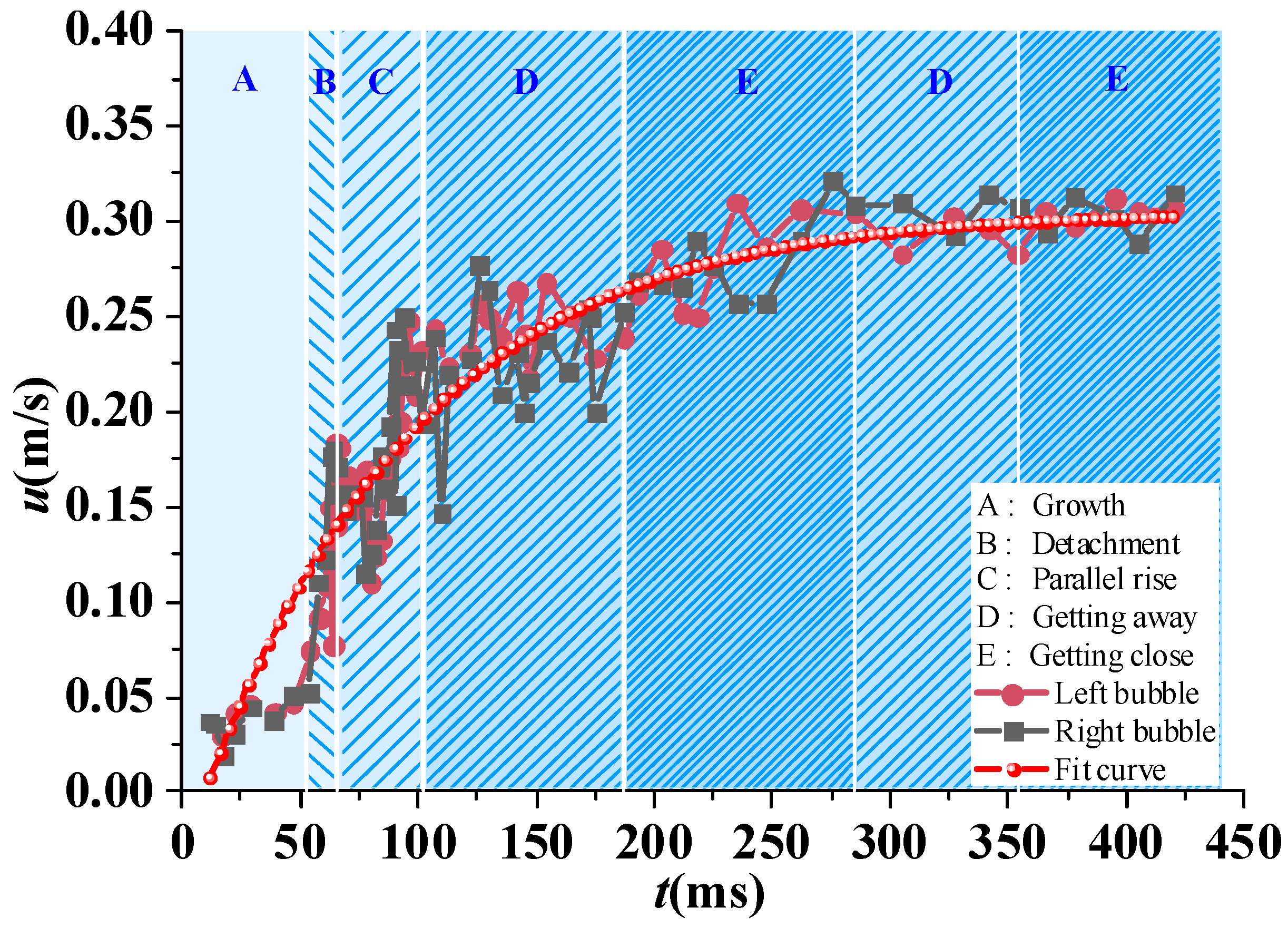

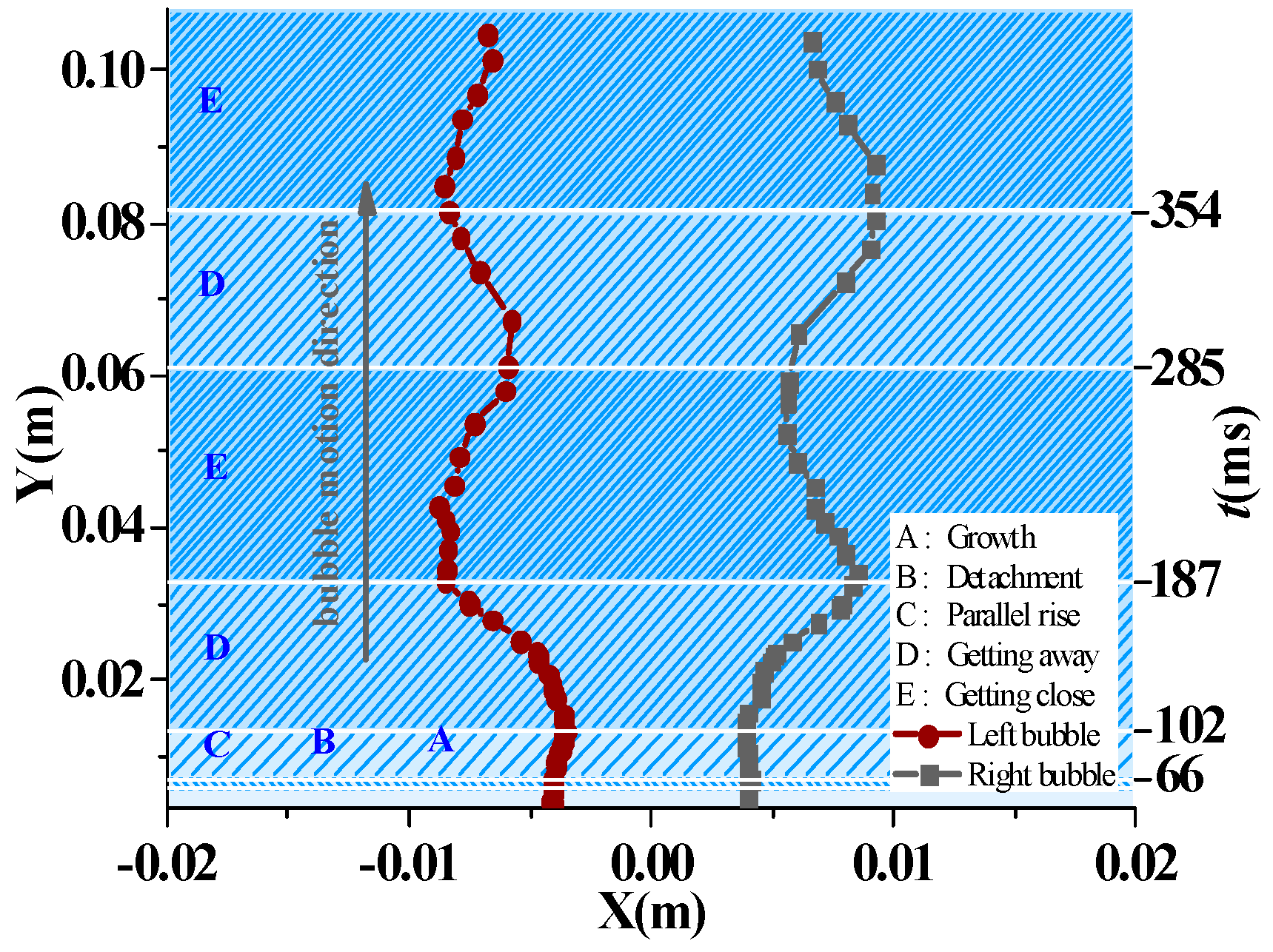

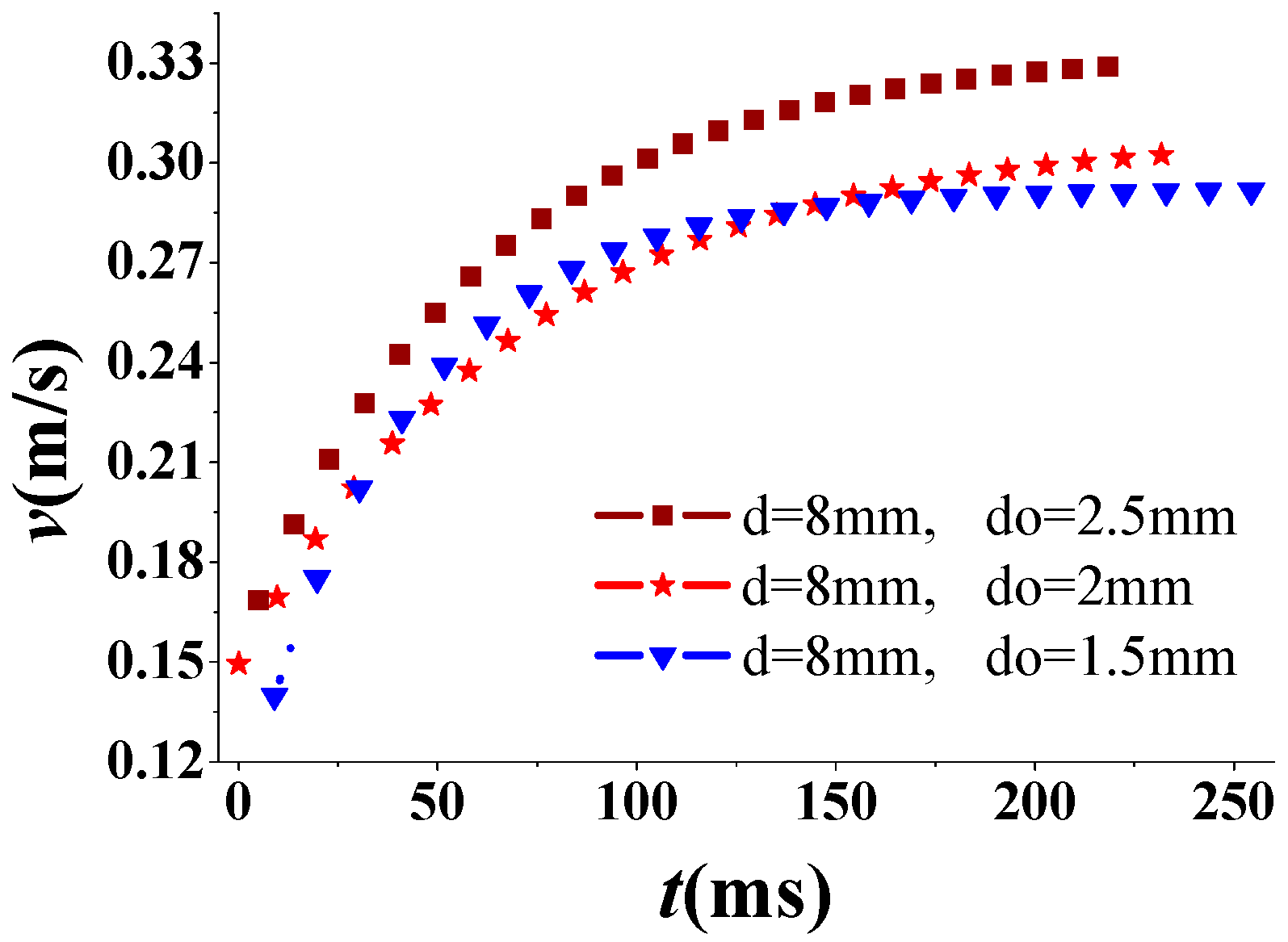
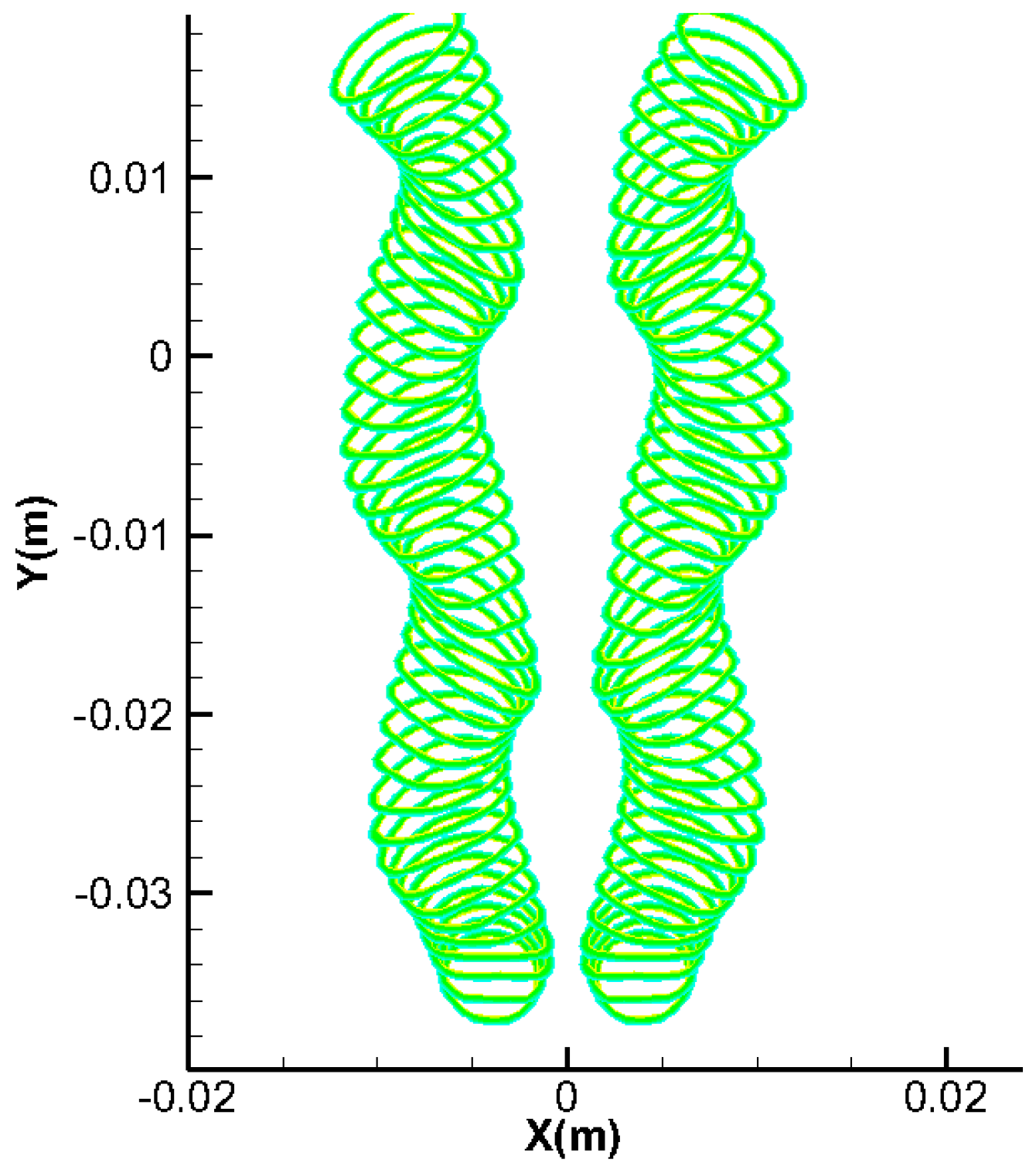
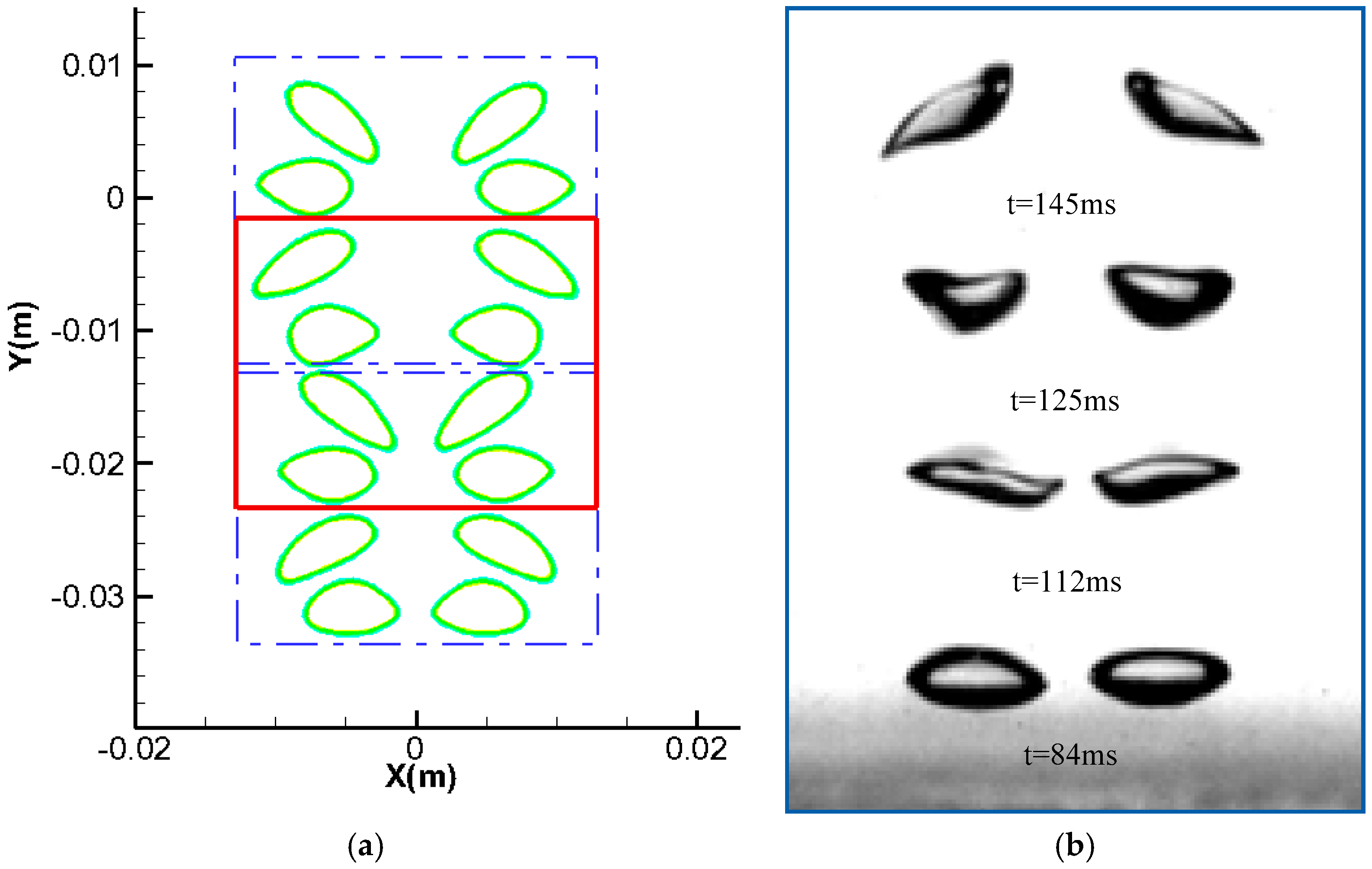
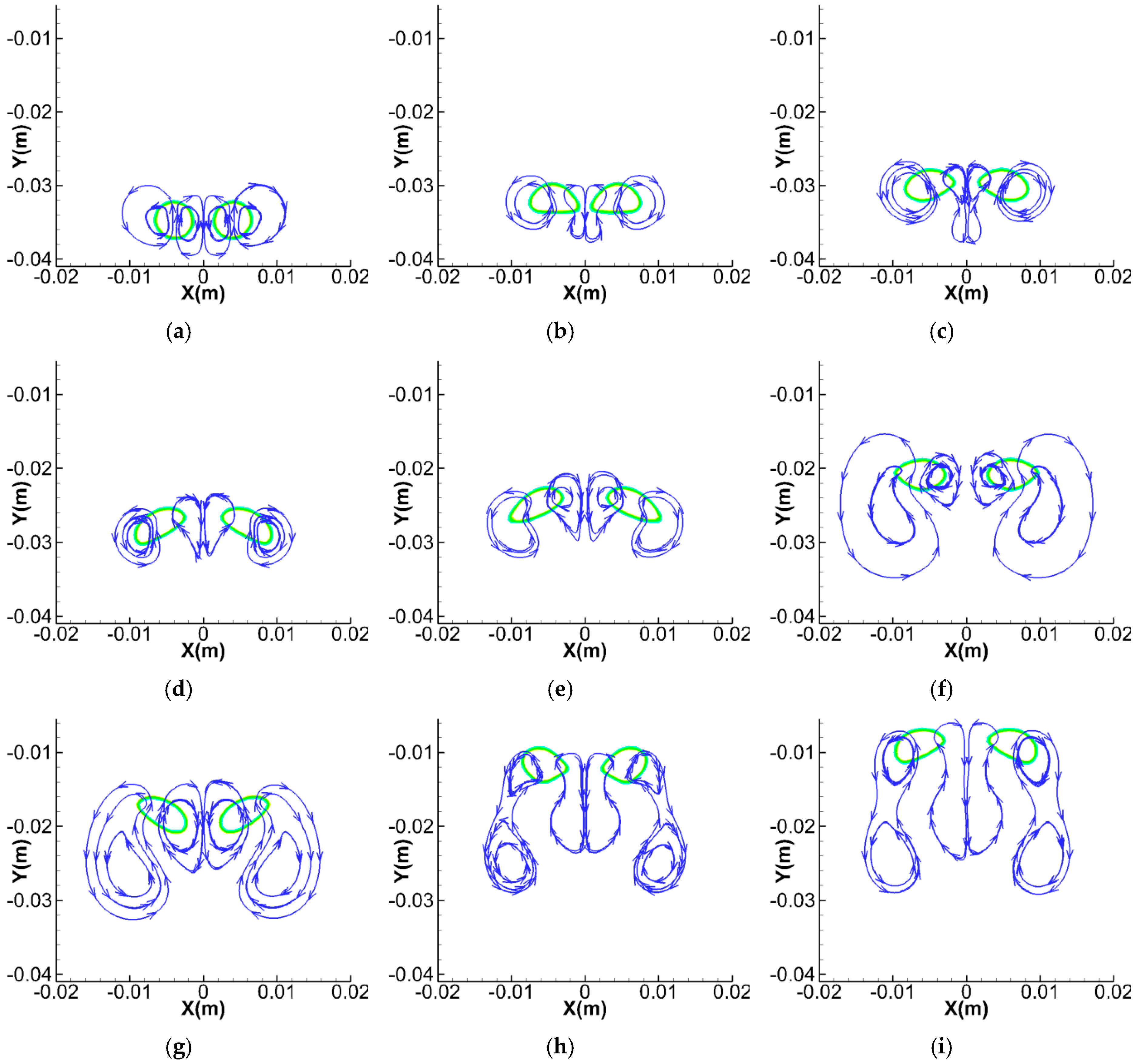


| Air Density | Water Density | Air Viscosity | Water Viscosity | Surface Tension | Morton Number |
|---|---|---|---|---|---|
| (kg/m3) | (kg/m3) | (Pa·s) | (Pa·s) | (N/m) | Mo |
| 1.225 | 988.2 | 1.7894 × 10−5 | 0.001 | 0.074 | 3.14 × 10−11 |
© 2019 by the authors. Licensee MDPI, Basel, Switzerland. This article is an open access article distributed under the terms and conditions of the Creative Commons Attribution (CC BY) license (http://creativecommons.org/licenses/by/4.0/).
Share and Cite
Ying, H.; Puzhen, G.; Chaoqun, W. Experimental and Numerical Investigation of Bubble–Bubble Interactions during the Process of Free Ascension. Energies 2019, 12, 1977. https://doi.org/10.3390/en12101977
Ying H, Puzhen G, Chaoqun W. Experimental and Numerical Investigation of Bubble–Bubble Interactions during the Process of Free Ascension. Energies. 2019; 12(10):1977. https://doi.org/10.3390/en12101977
Chicago/Turabian StyleYing, Huang, Gao Puzhen, and Wang Chaoqun. 2019. "Experimental and Numerical Investigation of Bubble–Bubble Interactions during the Process of Free Ascension" Energies 12, no. 10: 1977. https://doi.org/10.3390/en12101977




